
Sense's Reminiscences
by Sense de Jong
(Ex. 3:15)
- Geurt
- Tante Betje (by Sense)
- Tante Betje (by Truus)
- Miss Roozendaal
- Concert in Winschoten
- A baptism remembered
- My birdhouse
- War veterans
- Henk Smit - bass/baritone
- Stefan
- In memory of Herman - I
- In memory of Herman -II
- Remembering AK
- Our love for music
- Herman - Promoter of Christian Causes
- A Salem evening with Herman de Jong
- From Elsinore to Monschau
- A Danish Treat
- Glimpses of Thuringia and Saxony
- Domie and Hansie
- La Manche, Newfoundland
- Bermuda - Isle in the Sun
- 1932 and 1934
- 1940 - 1945
- Winschoten, Grace on the Venne
- 1948
- Johann Sebastian Bach
- From Generation to Generation
- Seven children and a harmonium
- K.P. - A Man of Enterprise
- Cuba and the tragedy of the MS St Louis
- It all began in Norwich, Ontario
Another site by Sense de Jong:
~ Hinne de Jong ~
A Chronicle
Sites by Henry de Jong:
~ Herman de Jong ~
Memorial
~ Newmaker Notes~
Writings, Pictures, Collections
~ AACS/ICS Niagara Conferences~
1970 - 1991
The time has come to say a bit more about our forebears and their families. Hopefully, this will be of benefit to our children, our grandchildren and our great-grandchildren.
Today (in 2015), when we - Corrie and I- call up the faces of all members of our large family we stand amazed at how our faithful Father in heaven has blessed us over all these
years in all kinds of circumstances. Our fervent prayer today, as always, is that we continue to hold high He who is called "I Am Who I Am," the name by which He wishes to be remembered from "generation to generation." (See Exodus 3)
This is not going to be an in-depth study of the genealogies of both my family (the de Jongs) and of Corrie (the Smits). We have evidence of the names of our forefathers going back to the 1700s and also of the places where they lived. We simply do not have enough information to write anything meaningful about those who came before our grandparents (our own parents’ fathers and mothers).
We want to focus a little bit on four families: de Jong (Sense’s father), Blokzijl (Sense’s mother), Smit (Corrie’s father) and Broekema (Corrie’s mother).
Sense’s father’s name is Hendrik (or Hinne), and you can read all about him in the foregoing "Hinne’s Chonicles." He was born and raised on the island of Terschelling (Skilge). My Dad was a real "Skilger." His Mom and Dad had a well-known farm on the island. My grandfather’s name is Cornelis Harmens de Jong. My grandmother’s name is Trijntje Stobbe. The picture below shows how many siblings Hinne had. He grew up on the farm, but in later years studied in Arnhem and became an official with a Dutch Crown Corporation involved in land reclamation.
Sense’s mother’s name is Hebowina Jantina Klazina Blokzijl (or simply Wine). She is the second youngest daughter of the large Blokzijl family. She was born and raised in the town of Ten Boer, close to the City of Groningen. My maternal grandfather’s name is Sense Blokzijl (I was named after him – as well as many of my cousins). He was a master-carpenter (he made an absolutely beautiful oak desk for my parents). My maternal grandmother’s name is Geertruid Visscher. I met my grandfather, but did not know grandma. She died in 1933. Opa Sense outlived her by 16 years. He died in 1949. The picture below shows how many siblings Wine, my mother, had.
Corrie’s father’s name is Kornelis Pieter Smit. He was born and raised in Aduard, a town
west of Groningen, close to Friesland. Corrie’s grandfather’s name was Hendrik Smit, born in 1863 in Den Horn. Hendrik was a blacksmith in Aduard and his business became well known as excellent forgers of agricultural tools from iron. Corrie’s grandmother’s name was Anje Schreuder, born in 1861 in Tinallinge. Corrie’s dad often was called just " K.P." Already at an early age he showed a talent for doing business. He travelled
extensively through the northern Dutch provinces, either by foot or bike, selling dry goods to isolated farm and town people. In later years he established a well-known dry goods store in Surhuisterveen. Early in the 1950s he and his family emigrated to Canada, settling in Sarnia, Ont. K.P was a member of a large family. Like Opa Smit, the kids were far from tall – they tended to be on the small size. See the picture printed elsewhere.
Corrie’s mother’s name is Afina Broekema. She was born and raised in Doezem/Grootegast, not that far away from Surhuisterveen. She had a twin sister, named Jantina. Corrie’s maternal grandfather’name was Kornelis Broekema and her maternal grandmother was called Grietje Kampen. The Broekemas were well known in the Doezem area as operators of a large windmill plus a small bakery. Well before she married K.P., Afina studied and obtained her nursing diploma in 1921 at the "Academisch Ziekenhuis" (Teaching Hospital), Hereweg, Groningen. It is amazing to realize that K.P. (born 1897) and Afina (born 1900), at the age of respectively 54 and 51 years, together with four children, decided to emigrate to Canada in 1951 starting a successful business enterprise in Sarnia, Ont.
Opa and Oma de Jong (Sense’s paternal grandparents)
Cornelis H. de Jong, born 28.88.1857 at Terschelling; died 04.08.1929 at Terschelling.
Trijntje Stobbe, born 04.06.1860 at Terschelling., died 27.09.1930 at Terschelling.
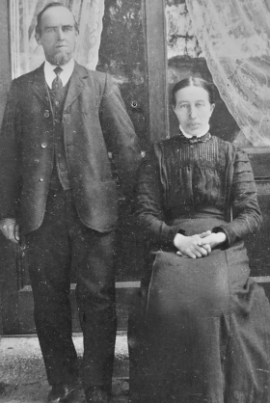
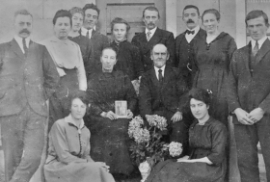
Opa and Oma Blokzijl (Sense’s maternal grandparents)
Sense Blokzijl, born 04.06, 1862 in Ten Post; died 17.11.1949 in Groningen
Geertruid Visscher, born 05.12.1863 in Westeremden,; died 23.09.1933 in Groningen
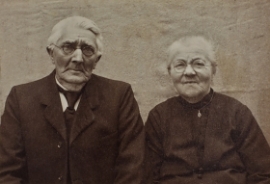
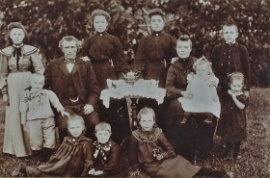
Opa and Oma Smit (Corrie’s paternal grandparents)
Hendrik Smit, born 25.03.1863 in Aduard; died 16.11.1917 in Aduard
Anje Scheuder, born 01.05.1861 in Tinallinge; died 28.11.1936 in Aduard
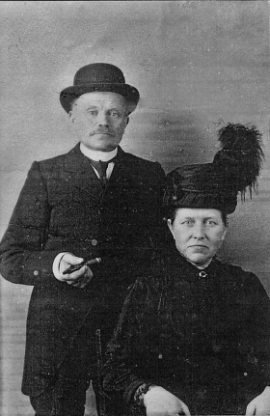
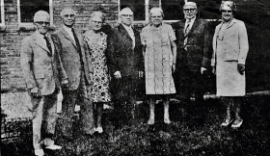
Opa and Oma Broekema (Corrie’s maternal grandparents)
Kornelis Broekema, born 04.12.1859 in Warffum; died 16.10.1938 in Noordhorn
Grietje Kampen, born 25.01.1861 in Hoogezand; died 14.06.1919 in Doezem.
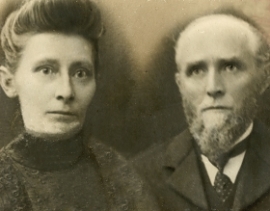
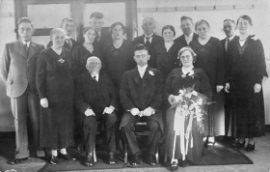
All of the above were "children of the Reformation." They might not have belonged to the same denomination, but they were committed to the Bible as God’s Word and to the historic Reformed (Biblical) confessions. The following story illustrates beautifully what I mean. Sometime in the early part of the last century, Kees (K.P.) joined a group of church people from the Surhuisterveen/Grootegast area to make a trip to Switzerland. They boarded a mountain train and slowly crawled up to the station high up in the Alps. After they disembarked and started walking around all of them were speechless as they took in the majestic sights of God’s creation. And spontaneously the group burst into a versification of Psalm 19:
"The heavens declare the glory of God;
the skies proclaim the work of his hands.
Day after day they pour forth speech;
night after night they display knowledge.
There is no speech or language
where their voice is not heard.
Their voice goes into all the earth,
their words to the ends of the world."
Interesting stories
Opa Hendrik - Kees and Koene’s Dad - was a lively little man and had many innovative ideas. He had the foresight to buy a steam engine for his blacksmithing business in Aduard. Soon deafening sounds emanated from his workshop, especially when the steam-driven hammer was put to work on a piece of steel. However, the Rev. Broekhuizen lived in the parsonage located behind the workshop and he complained he had difficulty making his sermons! Because of the noise pollution, Opa Hendrik and his boys decided to move the blacksmithing shop to a place outside the village. The result? A little factory which produced spades, hoes, hay forks and such. He invented a logo: "HEROS,’ an abbreviation of sorts of the name Hendrik-Roelof-Smit. His products were considered solidly made, guaranteed to last a long time. Even in 2015, one of our friends in Canada, who grew up in Aduard, remembers his father using "HEROS" garden tools!
As stated earlier, Corrie’s father, in his early years, travelled extensively through the area around Aduard, peddling dry goods to the people in the country. He either walked or biked or used a dog-drawn cart carrying his suitcase. One day, he called on the Broekema family in the village of Doezem. He rang the bell and who opened the door? That’s how Afina, Corrie’s mother, was introduced to K.P. They began a correspondence together and the relationship blossomed. At one point or another, they discovered they were second cousins! They began to see each other and the relationship blossomed. Afina was a trained nurse and already then she had an uncommon concern for people exposed regularly to the sometimes harsh Dutch climate. She also had a fear for water. She cautioned first her husband and then her kids never to sit in a "tocht" (draft). K.P had a bit of naughty streak. He and Afina would go off fishing in the Starkenborgh Canal just outside of Aduard. He’d go down to the water’s edge with his rod and tackle. Afina stayed close to the path above but tied a rope around K.P.‘s belt to keep him from falling into the canal! The kids remember how he sometimes winked at them and indicated that – how dare he! – had loosened his belt!
Opa Sense, as was mentioned earlier, was a master carpenter. We know little of his early training in building things, but we do know that during the Ten Boer years he became an architect/general contractor and was involved in the completion of some major
projects in the province of Groningen (possibly even the massive Oosterkerk in the city of Groningen). My internet research revealed that Sense Blokzijl was the architect on record of the "Kandelaarkerk" (literally: Candlestick Church) built in 1911 for the Protestant Reformed community in Schildwolde, Groningen! I also learned that he went
broke and that he and Oma Geertruid (their kids had either married or were working
elsewhere) decided to move away from Ten Boer. See following story.
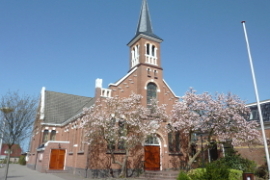
My mother’s parents, during the early 1920’s, moved from Ten Boer to Klazienaveen, close to the city of Emmen in the province of Drenthe. They struggled financially and decided to start a modest-sized grocery store. My mother, at that time, was employed in a "huishoudschool" (domestic science school) in the city of Groningen. From there she would make weekend visits to Klazienaveen. To supplement their income, Opa and Oma Blokzijl took in "kostgangers" (boarders). Lo and behold, one of them was none other than my father, Hinne (Hendrik) de Jong, who was then engaged by his company on a large land-reclaiming project in the area. And that’s how Wine and Hinne met each other for the first time! My mother, as everyone knows, was an extrovert; my Dad, an introvert. You couldn’t imagine how these opposite characters would ever get along. But meet they did, and soon they were out "wandelen" (walking) together. Already then, my Dad was very quiet, so different from my mother. But Hinne made a remarkable impression on Oma Blokzijl. During a talk with her daughter, she said: "Wine, that man may not say very much, but you will never get a better man than Henk!" The rest is history.
Oma Geertruid Visscher Blokzijl died September 23, 1933, in Groningen city. She was 70 years old. She had given birth to 13 children and did not have an easy life with her husband. Opa Sense was a very strict man and it was not easy to please him. Corrie and I once visited the grave in Haren (close to Groningen city) where Opa and Oma Blokzijl are buried. I’ve been told that at this graveside the Blokzijl family argued about what to do with Opa. He needed care now that Oma was gone. To resolve the dispute, my mother offered to take him home to Vlagtwedde. This was the place my parents, together with Kees, Truus and baby Herman, had moved to as a result of my Dad’s new work assignment. And so began another chapter in the de Jong family! They now had to get used to the presence each day of Opa Blokzijl, a man whose character clashed with my quiet, introverted father. And soon the old strictness and authoritarian attitude of Opa poisoned the de Jong home. My sister, Truus, related to me how Kees and she were petrified every time they gathered around the table. Opa ordered the two kids to sit straight, I mean: straight, cross your arms, and sit still. After devotions, Opa took his fork and gave two small ticks on the side of the plates of Kees and Truus. That was a sign that they could begin. But they were scared silly and sat straight in their chairs! This really infuriated Opa. He then gave three ticks and shouted: "Eat!" (In later years, Opa occasionally visited us in Winschoten. He would take the GADO bus from Groningen and got out at the Poelkenbrug, close to our home. I was then about four or five years old. Lo and behold, during meals Opa gave Herman and I the willies when he did exactly the same thing to us. I still hear those ticks today!) Opa’s stay in Vlagtwedde didn’t last long. His attitude led to a real blow-up with my Dad. After Opa scared the daylights out of Kees and Truus once more, my Dad exploded and said: "That’s enough! Either he goes out of this house, or I will!" I don’t know the details. All I know is that Opa Blokzijl left Vlagtwedde and was transferred to the home of my mother’s sister, Anje, who with her husband ran the "Christelijk Militair Tehuis" (Christian Home for the Military) located on the Hereweg in Groningen city. This is where I met this tall, aging Opa several times before the war. Opa died there in 1949. He was 87 years old.
To conclude, none of our forebears were perfect. Neither are we. But, with all our blemishes and shortcomings, God’s covenant promises remain the same. God, through Christ Jesus, our Lord, continues to love his people. God grant that all of us and our children heed His call by means of the gospel, that is, to repent and believe the good news about Jesus Christ. From generation to generation!
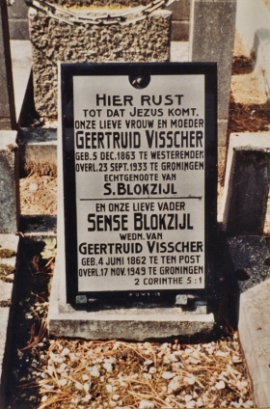
This is the text inscribed on the headstone of Opa and Oma Blokzijl’s graves in Haren, near Groningen city:
"Now we know that if the earthly tent we live in is destroyed, we have a building from God, an eternal house in heaven, not built by human hands." ( 2. Cor. 5:1)
August 2015
St. Catharines, Ont.
[an error occurred while processing this directive]